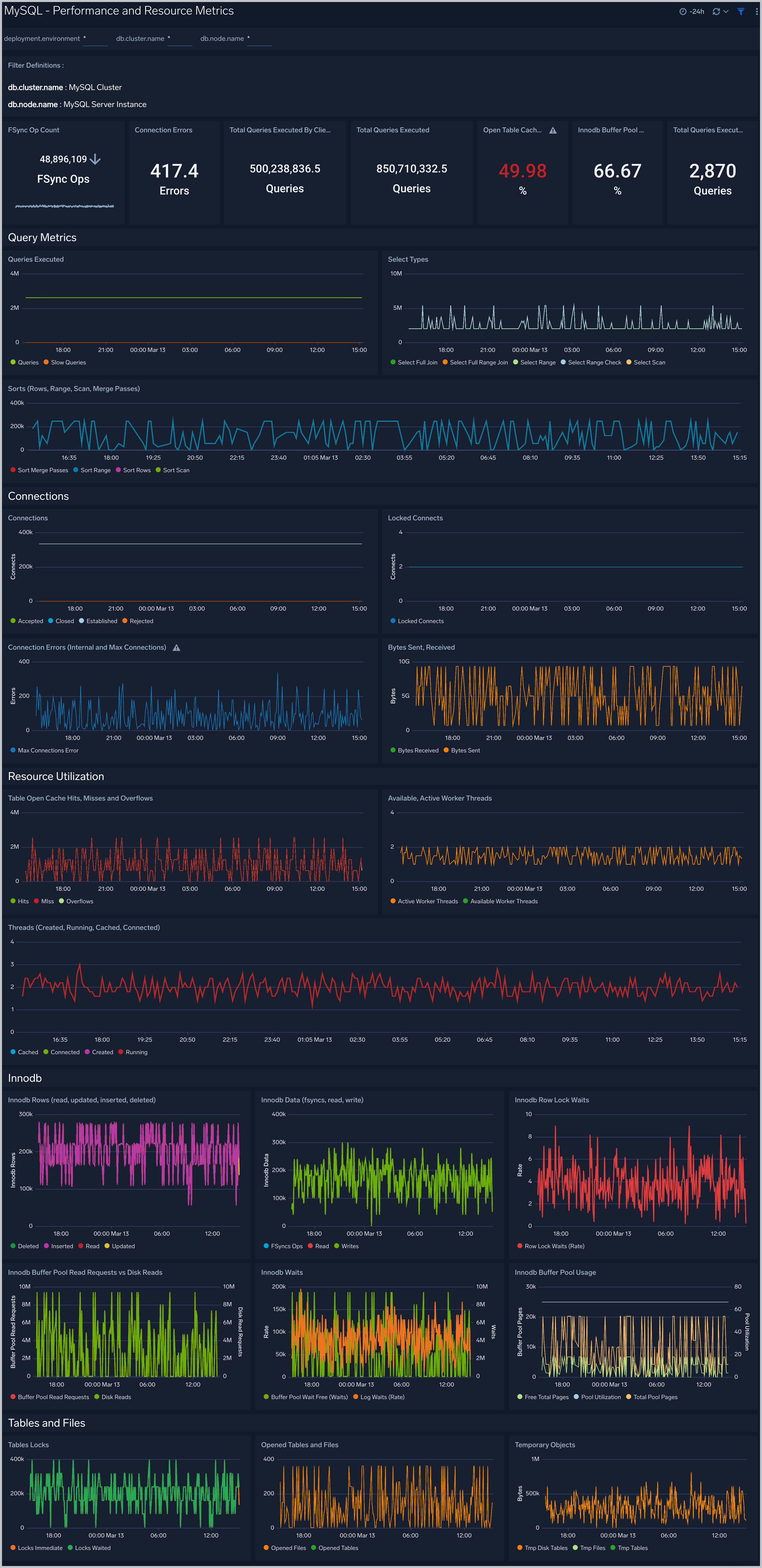MySQL - OpenTelemetry Collector

The Sumo Logic App for MySQL is a unified logs and metrics app that helps you monitor the availability, performance and resource utilization of MySQL database clusters. Preconfigured dashboards and searches provide insight into the health of your MySQL clusters, replication status, error logs, query performance, slow queries, Innodb operations, failed logins and error logs.
This App supports MySQL version 8.0.
We use the OpenTelemetry collector for MySQL metric collection and for collecting MySQL logs.
The diagram below illustrates the components of the MySQL collection for each database server. OpenTelemetry collector runs on the same host as MySQL, and uses the MySQL receiver to obtain MySQL metrics, and the Sumo Logic OpenTelemetry Exporter to send the metrics to Sumo Logic. MySQL logs are sent to Sumo Logic through a filelog receiver.
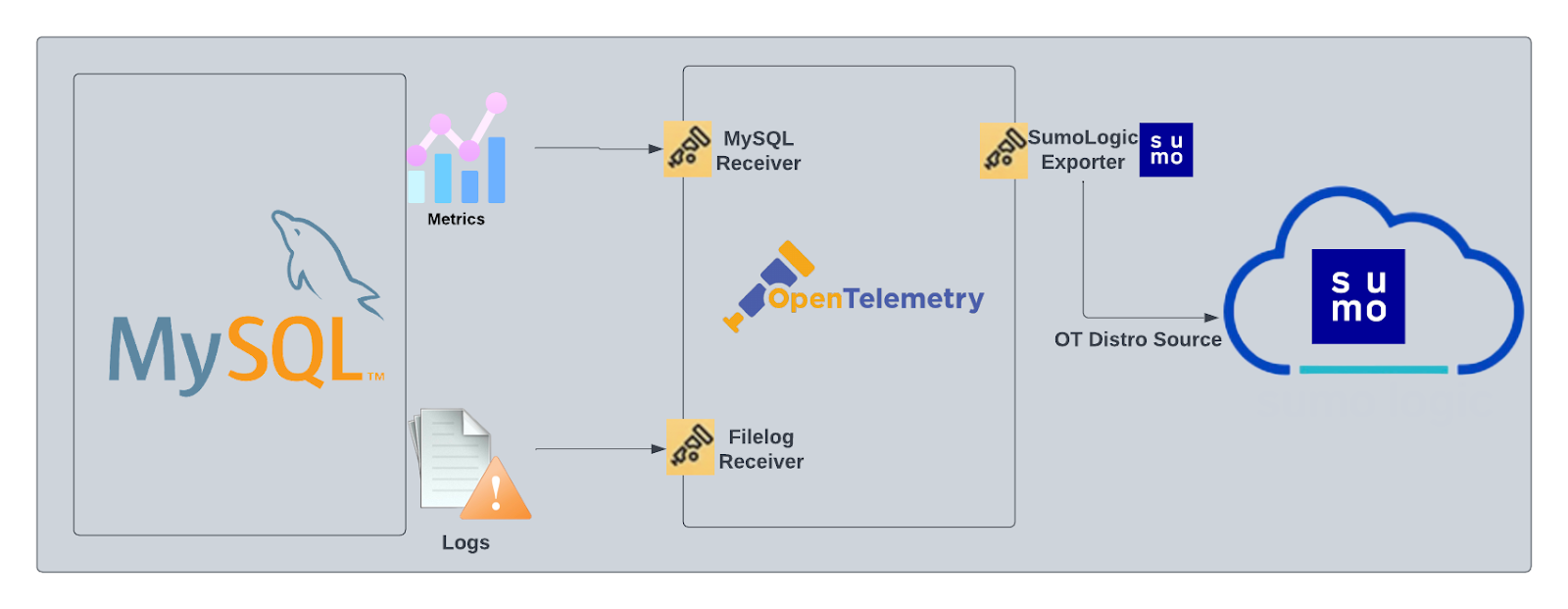
Log and Metrics Types
The Sumo Logic App for MySQL assumes the default MySQL Error log file format for error logs, and the MySQL Slow Query file format for slow query logs. For a list of metrics that are collected and used by the app, see MySQL Metrics.
- The MySQL - Overview dashboard is based on logs from both the Error and Slow Query log formats, so as to correlate information between the two.
- Dashboards in the Metrics folder are based on MySQL metrics.
- Dashboards in the Logs folder are based on MySQL logs from both the Error and Slow Query log formats.
- Dashboards based on the Error format:
- MySQL - Error Logs
- MySQL - Failed Logins
- MySQL - Replication
- Dashboard based on Slow Query format:
- MySQL - Slow Queries
- Dashboards based on the Error format:
- MySQL General Health is based on logs from the MySQL Error log format.
- MySQL Replication is based on logs from the MySQL Error log format.
- MySQL Slow Queries is based on logs from the MySQL Slow Queries log format.
The MySQL app dashboards dependent on error logs are based on the message types ERROR, NOTE, Warning, and Info. For more details on the MySQL log file format, see here.
Fields creation in Sumo Logic for MySQL
Following are the fields which will be created as part of MySQL App install if not already present.
db.cluster.name- User configured. Enter a name to identify this MySQL cluster. This cluster name will be shown in the Sumo Logic dashboards.db.system- Has fixed value of mysqlsumo.datasource- Has fixed value of mysqldb.node.name- Has the value of host name of the machine which is being monitored
Prerequisites
For metric collection: For metric collection here are the prerequisites.
For log collection: Configure MySQL to log to a local file(s). MySQL logs written to a log file can be collected via the Local File Source of a Sumo Logic Installed Collector. To configure the MySQL log file(s), locate your local my.cnf configuration file in the database directory.
- Open
my.cnfin a text editor. - Set the following parameters in the
[mysqld]section:[mysqld]
log_error = /var/log/mysql/error.log
slow_query_log=1
slow_query_log_file = /var/log/mysql/mysql-slow.log
long_query_time=2
long_query_time=2
Error Logs. By default, error logs are enabled and are logged at file specified by the log_error key.
Slow Query Logs. slow_query_log=1 enables logging of slow queries to the file specified by slow_query_log_file. Setting long_query_time=2 will cause queries that take more than two seconds to execute to be logged. The default value of long_query_time is 10 seconds.
General Query Logs. We don't recommend enabling general_log for performance reasons. These logs are not used by the Sumo Logic MySQL App.
- Save the
my.cnffile. - Restart the MySQL server:
sudo mysql.server restart
Collecting Logs, Metrics, and installing App for MySQL
Here are the steps for collecting logs, metrics, and installing the app.
Step 1 : Set up collector
If you want to use an existing OpenTelemetry Collector, you can skip this step by selecting the Use an existing Collector option.
To create a new Collector:
- Select the Add a new Collector option.
- Select the platform where you want to install the Sumo Logic OpenTelemetry Collector.
This will generate a command that you can execute in the machine environment you need to monitor. Once executed, it will install the Sumo Logic OpenTelemetry Collector.
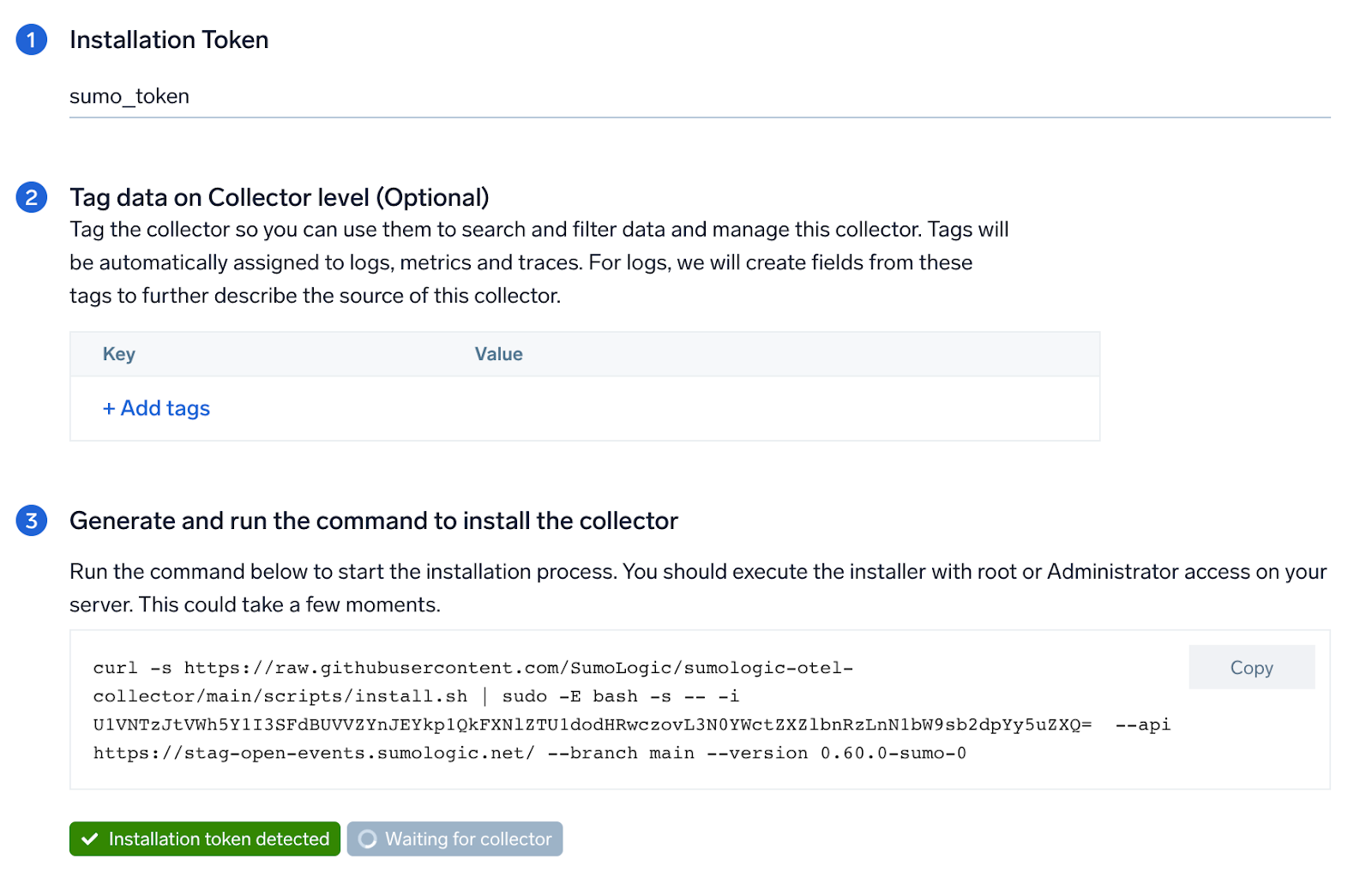
Step 2: Configure integration
In this step, you will configure the yaml required for MySQL collection.
Below are the required inputs:
- Endpoint. enter the url of the server which needs to be monitored
- User Name. enter the MySQL username.
- Error File log Path. enter the path to the error log file for your mysql instance.
- Slow Transaction file log path. enter the path to the slow log file for your mysql instance.
- Tags.
db.cluster.name.
You can add any custom fields which you want to tag along with the data ingested in Sumo.
Click on the Download YAML File button to get the yaml file.
For Linux platform, click Download Environment Variables File to get the file with the password which is supposed to be set as environment variable.

Step 3: Send logs and metrics to Sumo Logic
Once you have downloaded the yaml file as described in the previous step, follow the below steps based on your platform.
- Linux
- Windows
- macOS
- Copy the yaml file to
/etc/otelcol-sumo/conf.d/folder in the MySQL instance which needs to be monitored. - Place Env file in the following directory:
/etc/otelcol-sumo/env/ - restart the collector using:
sudo systemctl restart otelcol-sumo
- Copy the yaml file to
C:\ProgramData\Sumo Logic\OpenTelemetry Collector\config\conf.dfolder in the machine which needs to be monitored. - Restart the collector using:
Restart-Service -Name OtelcolSumo
- Copy the yaml file to
/etc/otelcol-sumo/conf.d/folder in the MySQL instance which needs to be monitored. - Restart the otelcol-sumo process using:
otelcol-sumo --config /etc/otelcol-sumo/sumologic.yaml --config "glob:/etc/otelcol-sumo/conf.d/*.yaml"
After successfully executing the above command, Sumo Logic will start receiving data from your host machine.
Click Next. This will install the app (dashboards and monitors) to your Sumo Logic Org.
Dashboard panels will start to fill automatically. It's important to note that each panel fills with data matching the time range query and received since the panel was created. Results won't immediately be available, but within 20 minutes, you'll see full graphs and maps.
Sample Logs
{
log.file.name:"mysqld-error.log",
log:"2022-10-14T09:16:02.430542Z 63707 [Note] [MY-010926] [Server] Access denied for user 'root'@'ip-10-0-16-79' (using password: YES)"
}
Sample Metric
{"queryId":"A","_source":"sumo_hosted_collector_otel_mysql","operation":"deleted","metric":"mysql.row_operations","db.cluster.name":"sumoCluster_otel","_collectorId":"000000000C59BB2E","deployment.environment":"sumodev_otel","_sourceId":"0000000000000000","unit":"1","db.system":"mysql","_sourceHost":"sumoOtelMysql","_collector":"sumo_hosted_collector_otel_mysql","max":0,"min":0,"avg":0,"sum":0,"latest":0,"count":4}
Sample Queries
This sample query is from the Top 10 Slow Queries by Average Execution Time panel.
db.system=mysql db.cluster.name={{db.cluster.name}} "User@Host" "Query_time"
| parse regex "(?<query_block># User@Host:[\S\s]+?SET timestamp=\d+;[\S\s]+?;)" multi
| parse regex field=query_block "# User@Host: \S+?\[(?<user>\S*?)\] @ (?<host_name>\S+)\s\[(?<ip_addr>\S*?)\]" nodrop
| parse regex field=query_block "# User@Host: \S+?\[(?<user>\S*?)\] @\s+\[(?<ip_addr>\S*?)\]\s+Id:\s+(?<Id>\d{1,10})" nodrop | parse regex field=query_block "# User@Host: \S+?\[(?<user>\S*?)\] @ (?<host_name>\S+)\s\[(?<ip_addr>\S*?)\]\s+Id:\s+(?<Id>\d{1,10})" | parse regex field=query_block "Schema: (?<schema>(?:\S*|\s)?)\s*Last_errno[\s\S]+?Query_time:\s+(?<query_time>[\d.]*)\s+Lock_time:\s+(?<lock_time>[\d.]*)\s+Rows_sent:\s+(?<rows_sent>[\d.]*)\s+Rows_examined:\s+(?<rows_examined>[\d.]*)\s+Rows_affected:\s+(?<rows_affected>[\d.]*)\s+Rows_read:\s+(?<rows_read>[\d.]*)\n" nodrop | parse regex field=query_block "Schema: (?<schema>(?:\S*|\s)?)\s*Last_errno[\s\S]+?\s+Killed:\s+\d+\n" nodrop | parse regex field=query_block "Query_time:\s+(?<query_time>[\d.]*)\s+Lock_time:\s+(?<lock_time>[\d.]*)\s+Rows_sent:\s+(?<rows_sent>[\d]*)\s+Rows_examined:\s+(?<rows_examined>[\d]*)\s+Rows_affected:\s+(?<rows_affected>[\d]*)\s+" nodrop | parse regex field=query_block "Query_time:\s+(?<query_time>[\d.]*)\s+Lock_time:\s+(?<lock_time>[\d.]*)\s+Rows_sent:\s+(?<rows_sent>[\d]*)\s+Rows_examined:\s+(?<rows_examined>[\d]*)"
| parse regex field=query_block "# Bytes_sent:\s+(?<bytes_sent>\d*)\s+Tmp_tables:\s+(?<tmp_tables>\d*)\s+Tmp_disk_tables:\s+(?<temp_disk_tables>\d*)\s+Tmp_table_sizes:\s+(?<tmp_table_sizes>\d*)\n" nodrop | parse regex field=query_block "# Bytes_sent:\s+(?<bytes_sent>\d*)\n" nodrop | parse regex field=query_block "SET timestamp=(?<set_timestamp>\d*);(?:\\n|\n)(?<sql_cmd>[\s\S]*);" nodrop
| fields -query_block
| avg(query_time) as avg_time, sum(query_time) as total_time, min(query_time) as min_time, max(query_time) as max_time, avg(rows_examined) as avg_rows_examined, avg(rows_sent) as avg_rows_sent, avg(Lock_Time) as avg_lock_time, count as frequency group by sql_cmd, db.cluster.name
| sort by avg_time | limit 10
This sample metrics query is from the FSync Op Count panel.
sumo.datasource=mysql deployment.environment=* db.cluster.name=* db.node.name=* metric=mysql.operations operation=fsyncs | sum
Viewing MySQL Dashboards
Overview
The MySQL - Overview dashboard gives you an at-a-glance view of the state of your database clusters by monitoring key cluster information such as errors, failed logins, errors, queries executed, slow queries, lock waits, uptime and more.
Use this dashboard to:
- Quickly identify the state of a given database cluster
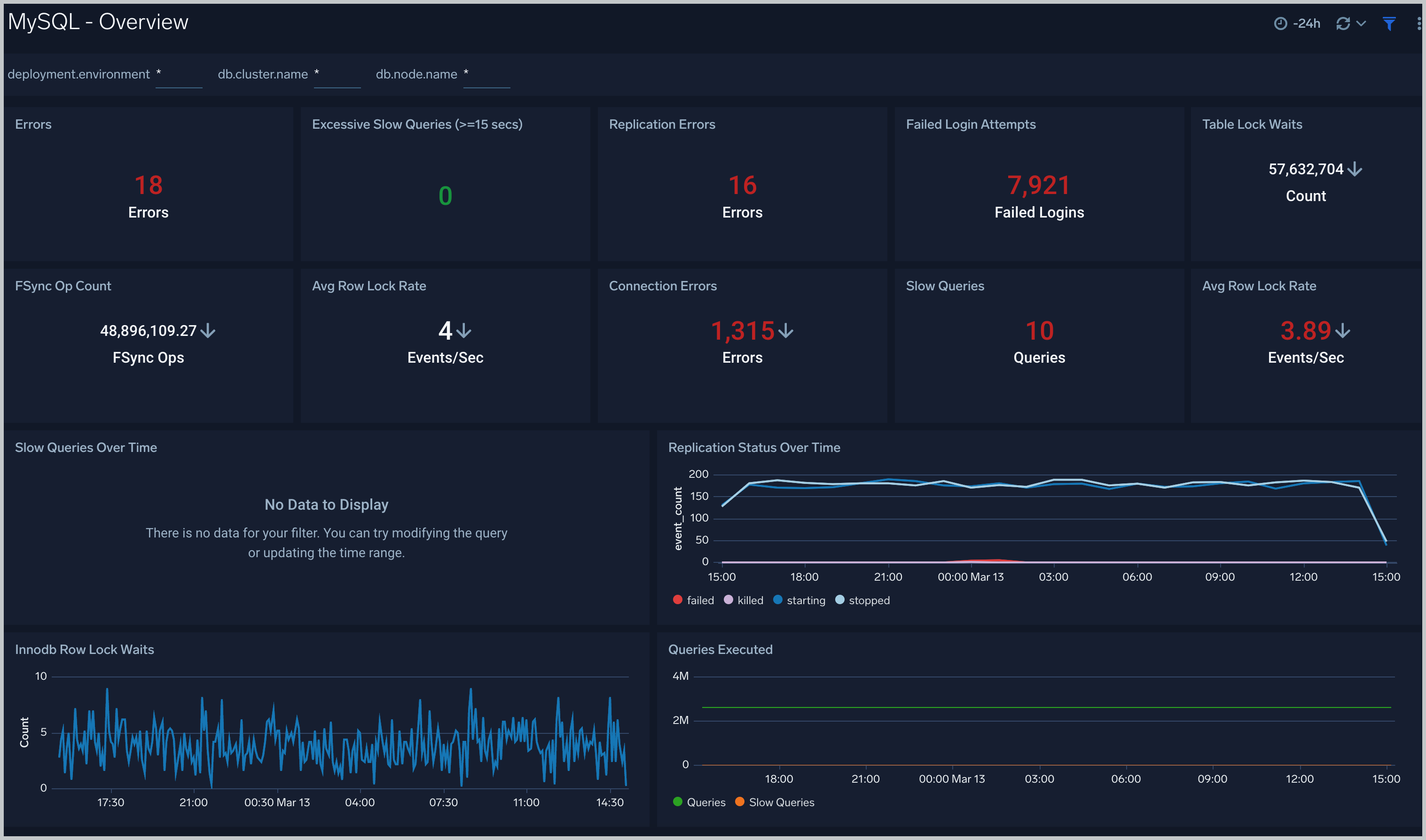
Error Logs
The MySQL - Error Logs dashboard provides insight into database error logs by specifically monitoring database shutdown/start events, errors over time, errors, warnings and crash recovery attempts.
Use this dashboard to:
- Quickly identify errors and patterns in logs for troubleshooting
- Monitor trends in error logs and identify outliers
- Ensure that server start, server stop and crash recovery events are in line with expectations
- Dashboard filters allow you to narrow a search for database cluster.
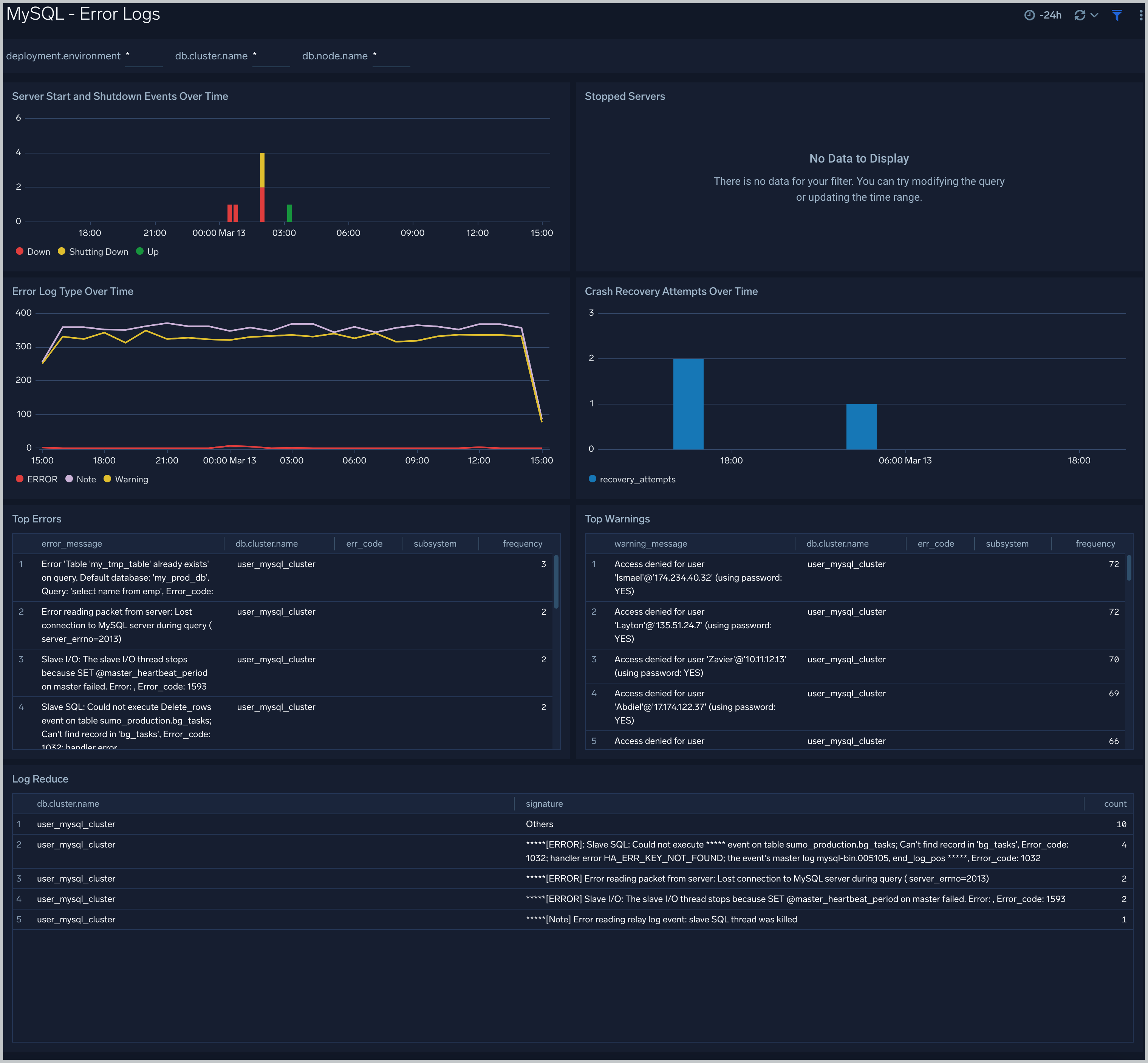
Failed Logins
The MySQL - Failed Logins dashboard provides insights into all failed login attempts by location, users and hosts.
Use this dashboard to:
- Monitor all failed login attempts and identify any unusual or suspicious activity
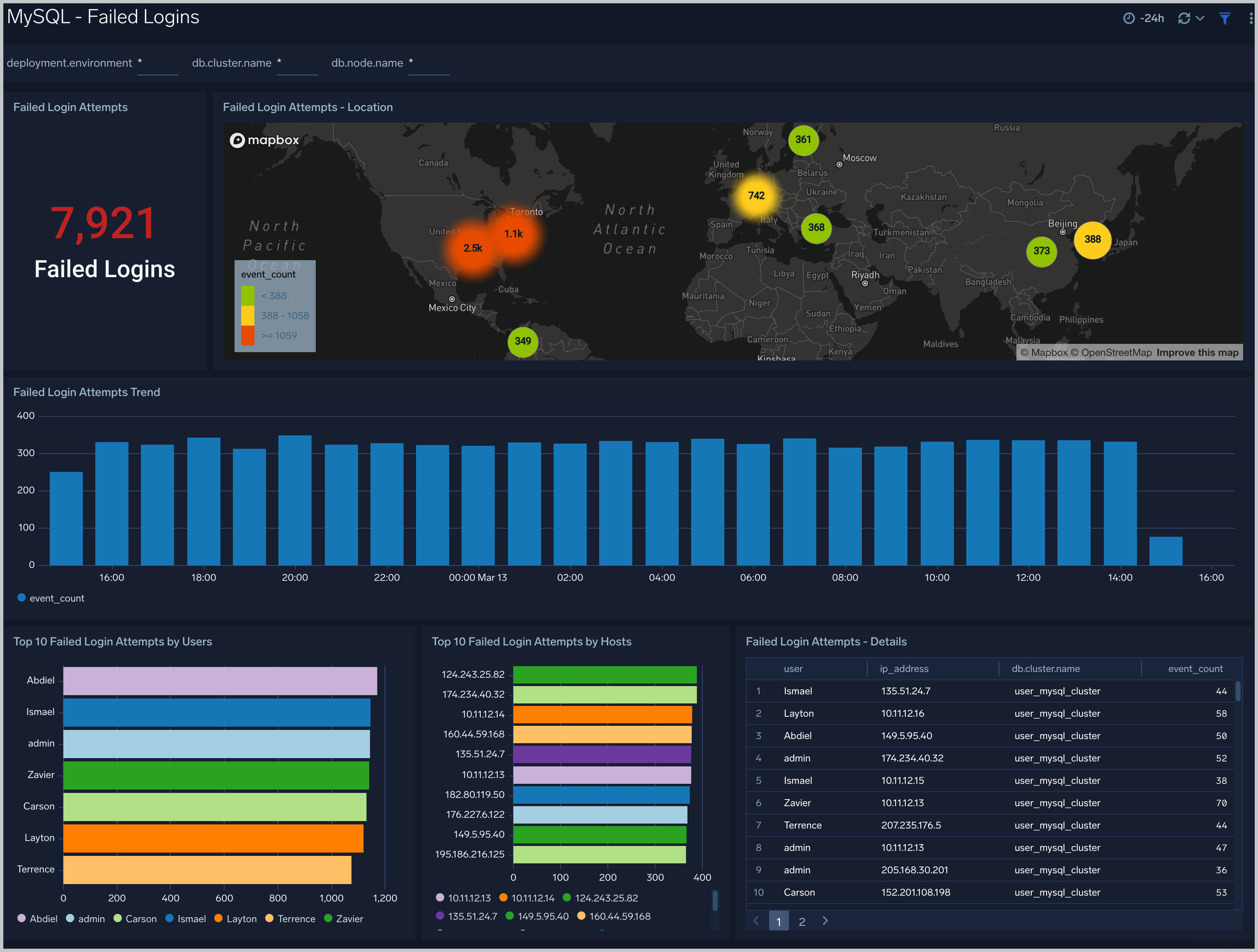
Replication
The MySQL - Replication dashboard provides insights into the state of database replication.
Use this dashboard to:
- Quickly determine reasons for replication failures
- Monitor replication status trends
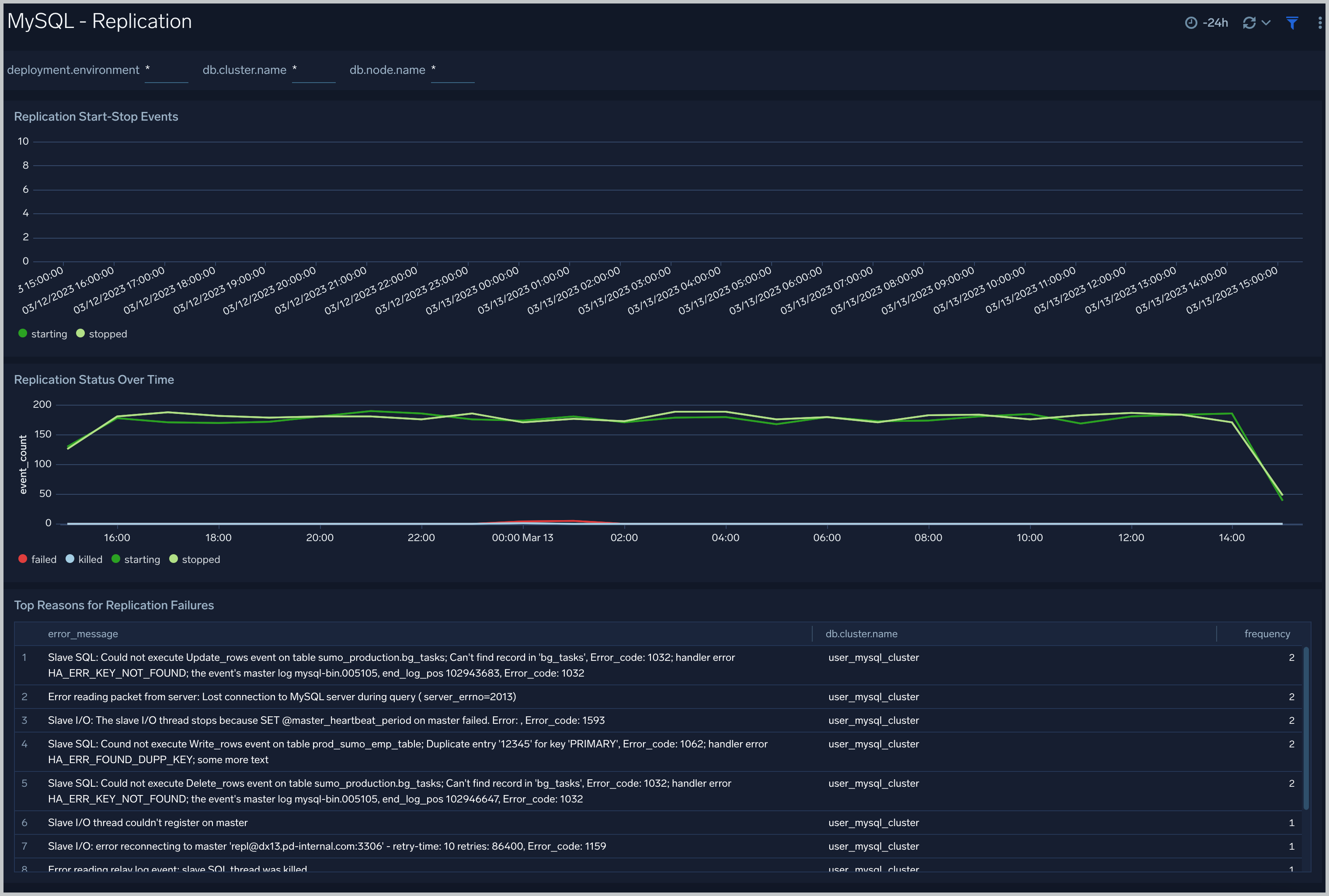
Slow Queries
The MySQL - Slow Queries dashboard provides insights into all slow queries executed on the database.
Note: Slow queries are queries that take 10 seconds or more to execute (default value is 10 seconds as per mysql configuration which can be altered) and excessive slow queries are those that take 15 seconds or more to execute.
Use this dashboard to:
- Identify all slow queries
- Quickly determine which queries have been identified as slow or excessive slow queries
- Monitor users and hosts running slow queries
- Determine which SQL commands are slower than others
- Examine slow query trends to determine if there are periodic performance bottlenecks in your database clusters
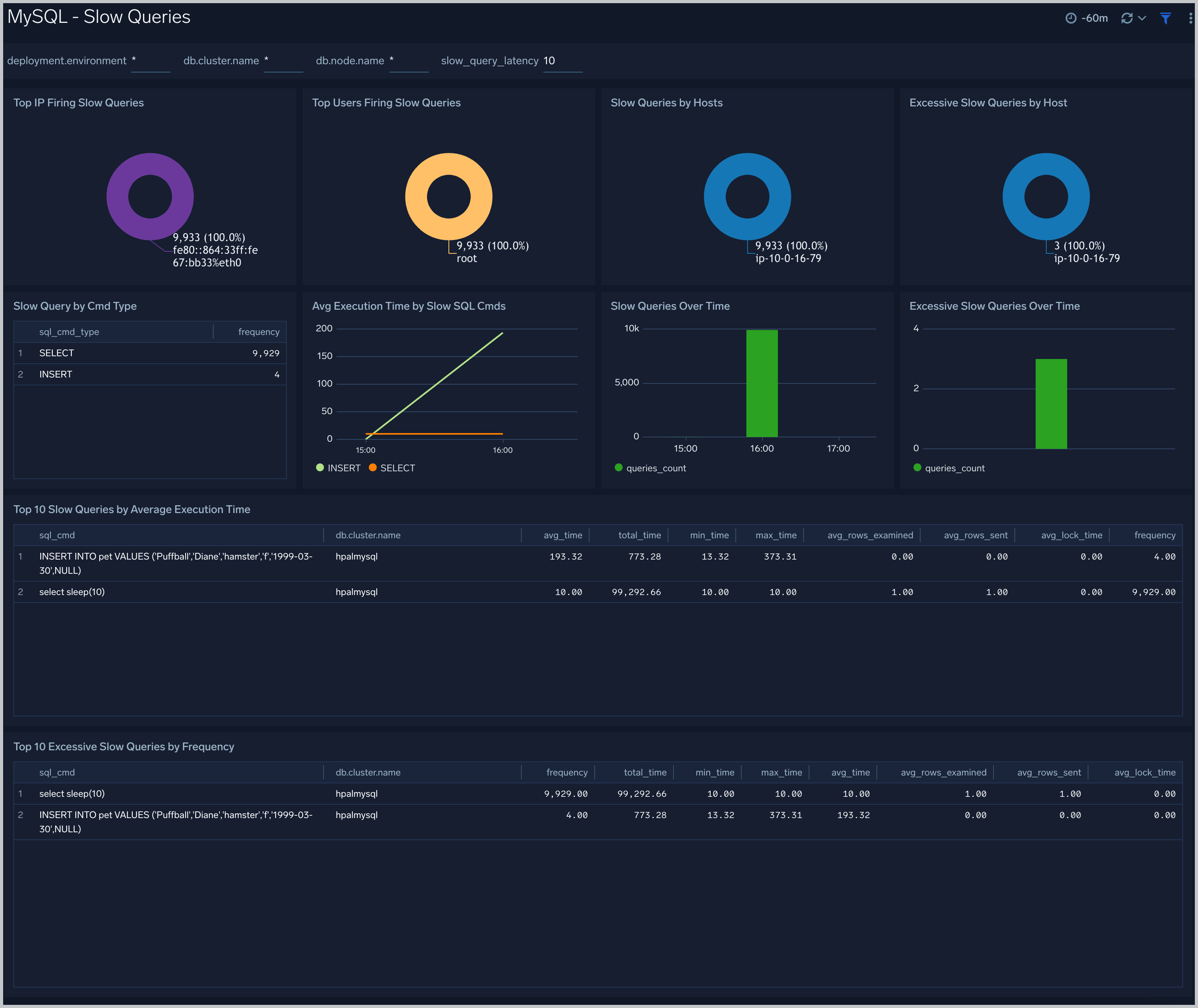
Performance and Resource Metrics
The MySQL - Performance and Resource Metrics dashboard allows you to monitor the performance and resource usage of your database clusters.
Use this dashboard to:
- Understand the behavior and performance of your database clusters
- Monitor key operational metrics around threads running, innodb waits and locks.
- Monitor query execution trends to ensure they match up with expectations
- Dashboard filters allow you to narrow a search for a specific database cluster
